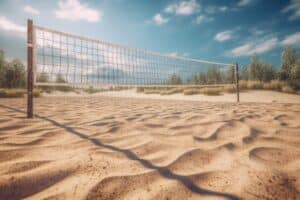Are Sand Volleyball Courts Smaller Than Indoor?
Key Takeaways
- Sand volleyball courts are smaller than indoor volleyball courts
- The smaller size of sand courts affects the strategies, player movements, and overall dynamics of the game
- The smaller size of sand courts demands quick and precise footwork, greater ball control and finesse, and a more compact style of play
Yes, sand volleyball courts are smaller than indoor volleyball courts. Sand volleyball courts typically measure 16 meters in length and 8 meters in width, while indoor courts are usually larger, with dimensions of 18 meters in length and 9 meters in width.
The smaller size of sand volleyball courts compared to indoor courts has a significant impact on the game. It affects the strategies, player movements, and overall dynamics of the sport. In this article, we will explore the differences between sand and indoor volleyball courts, highlighting the reasons why sand courts are smaller and how it influences the game.
The Dimensions of Sand Volleyball Courts
A sand volleyball court measures 16 meters by 8 meters, which is approximately 52 ½ feet by 26 ¼ feet. These dimensions provide a slightly smaller playing area compared to indoor volleyball courts. The court is rectangular in shape, with clearly defined boundary lines.
The smaller size of sand courts is intentional and designed to create a unique playing experience. The reduced dimensions make the game more challenging, requiring players to adapt their strategies and techniques to the sandy surface and limited court space.
The Dimensions of Indoor Volleyball Courts
Indoor volleyball courts, on the other hand, are larger than sand courts. They typically measure 18 meters in length and 9 meters in width, which is approximately 59 feet by 29 ½ feet. The increased dimensions of indoor courts provide more space for players to move and execute various tactics.
The larger size of indoor courts allows for longer rallies and more strategic plays. It also enables players to cover a larger area defensively and execute wider offensive plays. The additional space caters to the fast-paced nature of indoor volleyball.
The Impact of Court Size on the Game
The difference in court size between sand and indoor volleyball courts has several implications for the game:
1. Movement and Footwork
The smaller size of sand courts demands quick and precise footwork from players. With less space to cover, players need to be agile and efficient in their movements. The sandy surface adds an additional challenge, as it requires players to adjust their footing and balance.
In contrast, the larger size of indoor courts allows players to cover more ground, facilitating longer strides and smoother movements. The harder and more stable indoor surface also provides better traction, enabling players to move with greater ease.
2. Ball Control and Technique
The limited court space in sand volleyball necessitates greater ball control and finesse. Players must be more accurate in their sets, passes, and hits to keep the ball within the smaller boundaries. The sandy surface also affects the trajectory and speed of the ball, requiring players to adjust their techniques accordingly.
On the other hand, the larger court size in indoor volleyball allows for more powerful hits and higher jumps. Players have more room to generate momentum and execute various attacking techniques. The increased court space gives them more freedom to utilize their skills and create strategic plays.
3. Strategy and Tactics
The smaller size of sand courts encourages a more compact style of play. Players need to be efficient in their positioning and communication to cover the limited space effectively. The reduced court size also makes it challenging to execute wide offensive plays, emphasizing the importance of precision and coordination.
In indoor volleyball, the larger court size allows for a more diverse range of tactics. Teams can spread the court and create wider offensive plays, making it harder for the opposing team to defend. The increased space opens up opportunities for strategic plays, such as quick sets and back-row attacks.
4. Physical Demands
Due to the smaller court size, sand volleyball requires a higher level of physical endurance. With less space to cover, players must constantly move and react quickly to the ball. The sandy surface adds resistance, further increasing the physical demands of the game.
In indoor volleyball, the larger court size allows players to pace themselves more effectively. They have more time and space to recover between plays, reducing the overall physical strain during extended rallies.
In conclusion, sand volleyball courts are indeed smaller than indoor volleyball courts. The reduced dimensions of sand courts create a unique playing experience, demanding agility, precision, and adaptability from players. The larger size of indoor courts, on the other hand, provides more space for strategic plays and allows players to showcase their skills to a greater extent.
Related Websites:
FAQs:
Q: What are the unique features of sand volleyball?
Sand volleyball is played in an outdoor setting on a natural playing surface. The sand has a significant impact on gameplay, as it requires players to adjust their movement and techniques.
Q: How does indoor volleyball differ from sand volleyball?
Indoor volleyball is played on a hard surface in an indoor court setting. The type of flooring used in indoor volleyball also affects gameplay, providing a faster and more controlled playing environment.
Q: What are the standard dimensions of a sand volleyball court?
A standard sand volleyball court typically measures 52.5 feet in length and 26.25 feet in width. The boundaries are defined by lines, and the net height is set at 7 feet 11 5/8 inches for men and 7 feet 4 1/8 inches for women.
Q: Are there any variations in the dimensions of sand volleyball courts?
Professional sand volleyball may have specific regulations or guidelines regarding court dimensions. For recreational or backyard sand volleyball courts, there might be variations in dimensions based on available space and personal preferences.
Q: What are the standard dimensions of an indoor volleyball court?
An indoor volleyball court typically measures 59 feet in length and 29.5 feet in width. The boundaries are marked with lines, and the net height is set at 7 feet 11 5/8 inches for men and 7 feet 4 1/8 inches for women.






